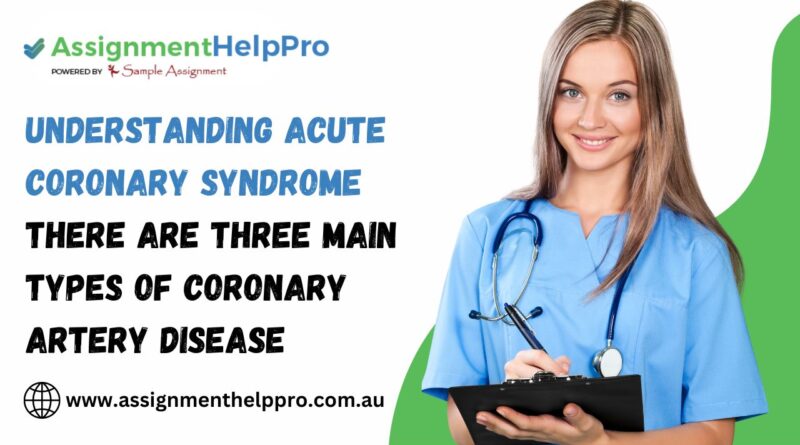What is Acute Coronary Syndrome?
The term acute coronary syndrome (ACS) refers to a group of serious and urgent conditions characterised by abruptly decreased heart blood flow. It’s a medical emergency that needs to be diagnosed and treated right away to avoid serious consequences like a heart attack and death. Understanding ACS is crucial for healthcare professionals, especially nurses, who are critical in identifying, treating, and managing patients with this condition.
This post will provide a detailed overview of acute coronary syndrome, its causes, symptoms, diagnosis, and treatment.
Understanding Acute Coronary Syndrome
Acute Coronary Syndrome encompasses three main types of coronary artery disease that are associated with the sudden obstruction of blood flow to the heart muscle.
Unstable Angina:
This is a disease in which the bloodstream to the heart organ is poor, leading to severe chest pain, primarily while at rest or when one engages in little activities. Unlike stable angina, which is characterised by episodes at regular times and for a short duration, unstable angina, which is irregular, may signal a heart attack.
Non-ST-Segment Elevation Myocardial Infarction (NSTEMI):
A type of heart attack is brought about by a 70% blockage of a coronary artery. It results in the death of cardiac muscle. It is milder than STEMIs. However, they both need immediate intervention.
These conditions are part and parcel of a spectrum of coronary artery disease, which is essentially ischemic heart disease, notably because the fundamental problem is the decreased blood flow to the heart, often precipitated by the formation of a blood clot over a site of ruptured atherosclerotic plaque.
Nursing Assignment Help Australia focuses on nursing subjects and assists nursing students with different assignments regarding ACS and other essential critical care subjects. These services range from writing to research and grasping concepts, and hence, they can complement the academic achievement of a student or a group of students in their learning process.
Precipitating factors of acute coronary syndrome
The main root of acute coronary syndrome is atherosclerosis, characterized by fatty substances (plaques) forming in the coronary arteries. When a plaque bursts, blood clots can initiate, thereby facilitating obstruction of the bloodstream to the heart.
Several risk factors contribute to the development of atherosclerosis and, subsequently, ACS:
High Cholesterol: High LDL cholesterol affects the arteries by creating plaque through atherosclerosis.
Smoking: Injures the internal lining of blood vessels and plays a role in the formation of atherosclerosis.
Diabetes: Raises the likelihood of having coronary artery disease because high sugar levels have a way of affecting the condition of the arteries.
Obesity: In its contribution to the development of risk factors such as hypertension, high cholesterol, and diabetes.
Sedentary Lifestyle: Inactivity can, therefore, be considered one of the leading causes of heart disease.
Family History: Heredity can be an influence on coronary artery disease.
Symptoms of Acute Coronary Syndrome
The symptoms of acute coronary syndrome can vary depending on the severity of the condition, but they typically include:
Chest pain or discomfort: This may be classified as a feeling of heaviness, tightening, or discomfort in the middle of the chest. It may also extend to the arms, neck, jaw, back, or other body areas, such as the shoulders.
Shortness of Breath: Shortness of breath when performing activities such as walking, climbing stairs or lying down.
Nausea or vomiting: Reports of side effects include complaints related to the gastrointestinal tract.
Sweating: Sweating is generally characterised as profuse, comprising “cold sweats.”
Dizziness or Lightheadedness: Some diagnosed presented a feeling of fainting or lightheadedness, which may result in fainting.
Fatigue: Frequent fatigue or going weak in the knees and becoming quickly tired without having to do much physical activity.
One must remember that some signs may be less revealed, particularly in women, older people, and those diagnosed with diabetes.
Management of acute coronary syndrome
Managing acute coronary syndrome depends on the type and severity of the condition and is usually time-sensitive. Therapy’s main objectives are to relieve the obstruction of blood supply to the heart muscles, reduce the size of the damaged area, and prevent further heart attacks.
Initial Management
To lessen heart discomfort and cardiac metabolic demands, aspirin, nitroglycerine, beta-blockers, and anticoagulants might be necessary.
Reperfusion Therapy
Using a catheter with a balloon on the end to get through the clogged artery is known as angioplasty. To guarantee that the artery won’t become blocked again, a stent is placed after the balloon has been inflated and deflated.
Long-Term Management
For long-term management, some medications that are prescribed are antiplatelets such as aspirin and clopidogrel, beta-blockers, ACE inhibitors, and statins. These medications regulate the risk factors and prevent future episodes of cardiac events.
The Role of Nurses in Managing Acute Coronary Syndrome
Acute Coronary Syndrome patients require a dedicated team of nurses at various stages of clinical practice, treatment, Education and counselling. Their responsibilities include:
Early Identification:
This is an understanding of one of the course’s fundamental aspects, namely the differential diagnosis of ACS and the beginning of its treatment.
Administering Medications:
The observation of results by supervising healthcare teams and the reconciliation of medications given to the patient to guarantee proper administration.
Patient Education:
Practical nursing interventions include teaching patients and families about illness, medications, and therapy, educating them about the need to change certain behaviours, and helping them stay on track with the prescribed medication.
Coordination of Care:
Working with other caregivers ensures that patients get the all-around care that others require and that transitions from one level of care to another are seamless.
Conclusion
Acute coronary syndrome is a serious condition that needs to be treated immediately. As a result, knowledge of the condition’s causes, symptoms, signs, and methods of diagnosis and treatment is essential for nursing professionals and students. Using resources such as online assessment help shared here, you can improve your knowledge and skills and positively impact nursing assignments.

